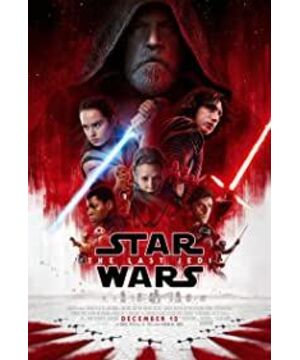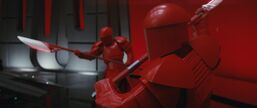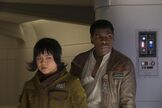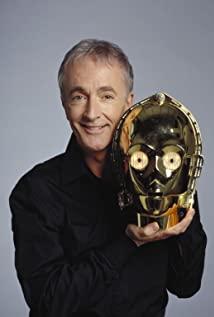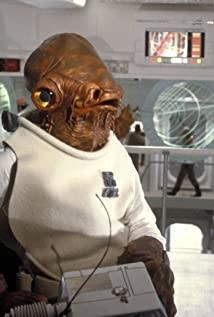"5 stars, there will be no Jedi from now on. It is not only the exit of the actor, but also the change of context. The context and symbols constructed by Lucas 40 years ago using Campbell's theory have been broken to the greatest extent in this book. The Internet context of the new century has appeared gorgeously in the demise of the confrontational context left over from World War II, and the youth of several generations have disappeared along with it. Will you miss that simple to rude but also because of the simple and pure context? What? The witness is gone."
Not talking about various interpretations, just talking about watching the movie directly, my evaluation of this film is also two words-it looks good! But for those who like this series and identify with the context and symbols of this series, is there really an "intuitive" viewing experience? The Star Wars series, especially the traditional trilogy, was born out of Campbell's "single mythology". A large number of symbols and character creations all have mythological prototypes that try to insinuate. And Star Wars 8 has a lot of use, destruction and reconstruction of series of symbols. Therefore, it is too difficult to watch the film without the awareness and interpretation of the various symbols and images of the Star Wars series that the creator placed in the film.
Let’s talk about this Star Wars 8 at the risk of over-interpretation.
The article is too long, let’s throw away the key points first:
1. Star Wars 8 is a subversion and innovation of the traditional Star Wars narrative context-it is not a simple inheritance or a complete abandonment. A logic needs to be clarified here, just as the counter-plot is not without plot but a subversion of the traditional plot. Abandoning a context cannot achieve subversion of a context. Subversion and innovation of the Star Wars context must be based on the use of traditional Star Wars context and symbols, which will lead to a certain familiarity, but in fact, the more similar, the more intense the subversion.
2. All subversions are not subversion for the sake of subversion. They collectively point to a change in the narrative context—a more modern Internet context replaces the confrontational context left over from the last century, especially the Second World War.
3. Three lines are indispensable, it is a discussion of the same motif at three levels: ① Rey line-the relationship between people and themselves. ②Fenn line-the relationship between people and others (self-interested or altruistic) ③Bo Dameron-the relationship between people and the world (to destroy the hatred or to protect the loved). In addition, the three lines also correspond to many classic scenarios and issues of Star Wars, such as the rich and poor issues involved in the Finn line, and the space battle scenes reserved by the Po Dameron line. The reason why the creator is so greedy to make every symbol appear in this movie is for that purpose- subversion and innovation .
1. Rey + Kylo Ren + Skywalker Luke (Heroic Journey)
1. Carrying the theme-the relationship between people and themselves.
You are the secret you have been searching for. ——Joseph Campbell, "Heroic Journey"
Rey's line is the true protagonist line, and it is also the most personal but essential entry point of the three lines. It deals with an ancient theme-the relationship between man and himself.
Specifically, the content of this line includes: ① Rey landed on Akto Island and found Luke-Luke found Master Yoda on Dagoba in the mapping forward. ② Luke's incomplete teaching of Rey—mapping and subverting Master Yoda's teaching of Luke. ③ Rey's exploration of the cave of mirrors-in response to the trial Luke received in the cave. ④ Rey and Kylo Ren tried to influence each other's wrestling-reflecting the wrestling between Luke and Darth Vader.
2. Symbols to be continued and subverted
①The self in the cave-the change of the motif
The cave you are afraid of entering contains the treasure you seek. ——Joseph Campbell
The cave is a metaphor for the deep hidden self, and all heroic journeys are actually the exploration of the self.
Rey's entry into the Mirror cave is the same as Luke's entry into the cave in Star Wars 2. It is a point of attack for the hero's journey. So are the self-directions that Luke and Rey found in the cave the same? If not, what kind of deep contextual changes are involved in the differences?
Let's look at the cave of the main story first.
After Luke entered the cave, he first saw his old enemy-the black warrior. After a fierce battle with a lightsaber, Luke finally beheaded his opponent, but the head that fell was his own face.
It is found that the greatest enemy is oneself. This plot is very metaphorical and highly fits the psychological themes of mankind in the 20th century. In the 19th century and before, people's self-exploration was even more led to the contradiction between humanity and divinity. In the 20th century, with the rapid development of science and technology, people seem to have become the masters of nature-"capitalized people" who don't need to surrender. But immediately, the dark side of technology was exposed. It magnified the good of mankind as well as the evil of mankind, and this kind of evil brought serious disasters to mankind in the last century.
The entanglement between light and darkness in one's heart is the subject of Luke and Darth Vader's exploration of both sides in the original biography.
Look at the cave in Star Wars 8.
Roy entered the cave and saw herself-an endless self. When she prayed to be informed of her parents' identity (seeking a sense of belonging), all she saw in the end was only herself, which made her fall into the deepest loneliness.
This image is a portrayal of the human plight in the Internet era in the 21st century. Liang Wendao’s previously published article "The Self in the Internet Age" constructs an image that is very similar to the film:
We have entered an Internet era where there is clearly a huge amount of information, and we have entered a space where all kinds of sounds exist, but we don’t know why we seem to have walked into a hall of mirrors. There are mirrors everywhere in the hall. No matter where I look, I can only see my face. It is a secret room. No matter who I talk to, I only hear my own echo. ——Liang Wendao: "The Self in the Internet Age"
What kind of dilemma is this? This is a dilemma of self-confirmation. The so-called self of people in the Internet age has been infinitely magnified, but they have forgotten that people’s self has always been confirmed by others. On the Internet, we can arbitrarily filter, only see and listen to what we want to see and hear. So, the other than ourselves is eliminated, and we are lost in the ocean of ourselves...
Let’s hear what Rey himself described in the film about his experience in the cave of mirrors.
Rey: "It seems like there is no end to me, but there will be an end, where I can find the answer... But I was wrong, there was nothing, I have never felt so alone. "
It's really a human psychological confession in the Internet age-there are mirror images of yourself everywhere, but this endless self is extremely lonely.
Therefore, the themes discussed by Kylo Ren and Roy in Star Wars 8 in Star Wars 8 have been very different from the main story, showing the new motif of human self-exploration in the Internet age: the self can really get rid of the other and get perfect. Does it exist?
②The breaking of the core of the Force: Towards the abyss of nihilism-the death of Luke
"The reason why a person is great is that he is a bridge rather than a goal. The reason why a person is lovely is that he is a transition and a kind of destruction."-Nietzsche
The breaking of the core of the Force is another important subversion and extension of Star Wars 8 to the Star Wars series. I did something that I either didn’t want to do or didn’t dare to do in the first 7 parts-staring into the abyss (the gaze is a bit exaggerated, but at least it is a big glance), I am not sure where this star wars series will lead this star wars series. But what can't be denied is its extraordinary significance.
Regardless of whether it was the prequel or the main story, the narrative of the Force at most was limited to the same clan and the same origin, and mutual conversion. Attentive audiences will find that if you take a small step forward along this logic, you can reach the terrible problem of Star Wars 8 without obstacles, but the choices of the first 7 parts are firm and never take a half step forward. !
In my opinion, this kind of stopping is prudent and worthy of respect. The reason is simple but profound: half a step forward is an abyss that has no bottom and nowhere to stand on-nihilism.
Facing the abyss, the main creator of Star Wars 8 showed fearlessness like Roy, and it was this fearlessness that made me, as an audience, feel the same fearless as Luke!
The point of this fear is the dilemma of why myths and stories exist after the emptiness is broken. Because, in the final analysis, the mission carried by myths and stories is to give meaning to the complicated life, so as to prevent human beings from facing nothingness .
In fact, there is a very extreme solution to this dilemma, and it is also shown in the film, that is Luke's way.
After Luke realized the emptiness of the force, he made a very Taoist response: retreat completely . As a result, he cut off the connection with the Force-just as Lao Zi retreats "the sound of the chicken and the dog will hear each other, the old and the dead will not communicate with each other".
But there is a problem with this solution, which is that it cannot become the soil for the growth of myths and stories, so when it is pointed out, it is immediately broken. What breaks it is a Nietzsche-like self-awareness—"I" is not a goal, but just a road. Therefore, what Luke has accomplished in this Star Wars is the transformation from "New Hope" to "The Road to New Hope", which conveys a power that transcends nothingness. Luke is bound to retreat in this film. The creator simply sacrifices his perfect image in exchange for the power of future generations to step into the abyss. Perhaps this is the most deadly way? Wipe away your tears and move on!
③ Helmet-a sense of form that has been dispelled
It makes sense for Star Wars to be referred to as a "space opera". As an opera, the sense of form is particularly important. If the breaking of the helmet can be regarded as a reverse form of construction to some extent, then the addition of a lot of Marvel movie-style jokes really destroys the sense of form in Star Wars.
But after all, how much sense of form can survive the Internet era? The celebrities who used to be aloof are now putting down their shelves and showing themselves as civilians in Weibo and variety entertainment. The art of opera itself has been almost wiped out by popular music. From this point of view, Star Wars' approach to a civilian context is also the general trend. Although it lacks some texture, it may be more close to the people? But in any case, it is always gratifying to see so many viewers expressing dissatisfaction with this. I hope that Star Wars will not be attacked by the "general trend" so quickly.
④ Master and apprentice, ancient trees, ancient books-teaching and inheritance reformed on the Internet
The master-disciple relationship between Luke and Rey in this film mirrors the master-disciple relationship between Luke and Master Yoda in the main story. The plot in this film has also been criticized by many fans. ——Why didn't Luke teach anything practical in the end, and under this condition, Roy was able to pass without a teacher to the realm of being able to fight against the guards of the big boss Snook.
But to some extent this arrangement is the most appropriate.
In the traditional Star Wars, the inheritance of the skills of the Jedi Knights is quite medieval guild color, apprenticeship, uniform clothing arrangement, apprentices respect for the master.
In the Internet age, this kind of teacher-student relationship has long ceased to exist, and even the memory of it has faded. At the moment, people who are connected to the Internet can search for the knowledge they need. Various self-help books and websites not only guide our exploration of the outer world but also guide our exploration of the inner world.
Before Luke on the island taught Roy the core of the Force, he only taught a knowledge of reality. That is "reach out". This teaching is so action-oriented that at first Roy understood that in order to reach out, I felt that this action was extremely compatible with another real-life image of "stretching out", that is-surfing the Internet. In this way, from a practical perspective, Luke's so-called professor only taught Roy how to connect to the Internet.
The penance in the main story becomes the teaching of connecting with the Force (Internet) in Star Wars 8, and then Rey can become stronger by himself (online self-study). We can even say that Luke's fear of Rey and Kylo Lun's force is like the fear of the Internet being too large and powerful. And Luke's way of dissolving this fear is also in the context of the Internet, he chose to cut off the connection with the Force. Cutting off-disconnecting the network is another mapping that fits well.
Let's talk about ancient trees and ancient books, the burned ancient trees and the books inside (although the final announcement has been taken out, but the words of Master Yoda still sentenced them to death-anyway, they will not be read in detail). Master Yoda said: "Perhaps it is not the Jedi Knights that should be destroyed but those books." I don't know if this one is still in the book that the creator of this line wants to destroy.
It is no longer necessary to study the classics repeatedly like the monks in the Middle Ages, and all the knowledge is fast-paced for self-service, so what else can the teacher teach? What else do we need to learn? What Master Yoda said to Luke is summarized as follows: What you can teach is no longer knowledge itself, but all your efforts to explore knowledge, including and especially the failures. For us in the Internet age, this is really a very deep admonition.
2. Finn + Rose + DJ line
1. Carrying the theme: the relationship between people and others-self-interest or altruism.
The discussion of egoism in the traditional Star Wars is mostly carried by Han Solo. From a self-interested space scoundrel to a resistance hero, Han Solo’s heroic path best reflects the American spirit.
Egoism, an important aspect of the American spiritual core, runs through all aspects of American life. What is behind laws such as gun legalization is the supreme concern for personal interests. Most Americans firmly believe in a creed: a moral self-interest can lead to justice and is deeply rooted.
So how will this theme be revealed in this Star Wars 8?
2. Symbols to be continued and subverted
①Princess Leia-Rose
Judging from the first half of Star Wars 8, its discussion on this topic is still very traditional. A very core logic is continued, that is-the two must be bundled together. In order to achieve this inheritance, with Rey's own mission, the role of Rose appeared.
For Finn, Rose’s appearance actually played the role of Princess Leia’s guiding role for Han Solo in the original biography—yes, Finn more or less represents Han Solo (not to mention that people are not handsome Well). In the end, giving up to save Finn also made Rose a propelling role for the traditional female role of Star Wars, and the driving force of the sisters' affection is also very "Frozen".
②Finn’s two close-ups: the first inheritance, the second expansion-the nihilism that was once again revealed
In Star Wars 8, Finn was asked twice to revisit the scene he thought he had seen.
For the first time, at the casino, Finn lamented the wealth of the casino, wondering why Rose hated it so much, so Rose asked him to take a closer look. So Finn saw the hidden evil under Fuhua, the oppressed slave. Although in a hurry, Finn completed his first transformation in this work, caring about others who have nothing to do with him (rather than just caring about Roy, who was just his favorite at the beginning of the film).
However, the test of Finn did not end there, and the creator arranged for him to take a second look. On the spaceship, when Finn, who had been biased towards justice under the influence of Rose, expressed his indignation towards the arms dealer, DJ asked Finn to take a second look. And this closer look once again reveals the topic of nihilism that I want to explore in the first line. The arms dealer that Finn referred to as "evil" was actually providing weapons to the rebels, thus nihilizing Finn's criteria for "good and evil". And DJ timely throws out his own method of dealing with this dilemma-Don't Join. (Don't join)
To a certain extent, from this moment on, DJ is more like a representative of a certain spiritual flow in the United States today-a kind of self-interest under the rise of conservatism, self-interest that does not talk about international responsibility (who can say this kind of responsibility? Is it possible to be self-righteous?), a real businessman's face. At the same time, this self-interest also leads to the isolation of others mentioned in the Roy line.
The good news is that when DJ betrayed Finn and Rose said: "There is no justice or error in war. It's just a game where you play me today and I will play you tomorrow." Finn still resisted this hard. From the nihilistic viewpoint, he replied firmly: "You are wrong." And then tried to practice his own words in the final battle, Finn is currently regarded as a hero of the unity of knowledge and action.
However, the phrase when DJ was leaving: "Maybe." It is always a reminder that it is a kind of worry that is more than simple mythological context and facing reality, which is quite meaningful.
I don't know if DJ will play in the next episode, but I think the main creator's test of Finn will not end here, and it will force him to make more detailed observations and more choices.
3. Po Dameron + Princess Leia + Amilyn Jordo Line
1. Carrying the theme: the relationship between man and the world-to destroy the hated or to protect the loved
Po Dameron actually appeared as an apprentice in this line. His most exciting performance was not in several air strikes and nearly successful coups, but in the final retreat and escape that he ordered. Behind it is that the two female characters in this line have become more or less mentor-like existences, teaching Bo Dameron to understand a more feminist, non-confrontational heroism.
Understand this context, and then look at the multiple reversals that occur in this line to truly understand the flavor. In fact, what matters is not which method ultimately succeeds, but whether the starting point for making this choice is to protect the loved one. (But in fact, there are still BUGs, which are acceptable.)
Four. Knot
Generally speaking, I am satisfied with this Star Wars, and I feel shocked. It's not the special effects or blood-spraying fights in the picture that are thrilling, but it actually breaks the inherent framework of Star Wars so boldly, leading the audience to the horrified unknown abyss. For an old series with a 40-year history, this is not easy. The courage and emphasis on love shown behind the change of context is also worthy of respect, and the contradictions discussed are more in line with the context of the Internet era. All these make me think that this may be a spiritual myth that is more suitable for the Internet age. It’s just that I, a predecessor of the Internet era, inevitably have a little nostalgia for the past...
Finally, I wish Star Wars 9 success, and hope that it is good enough to make me shout out the sentence without fear: Let the past die!
View more about Star Wars: Episode VIII - The Last Jedi reviews


